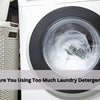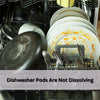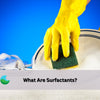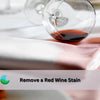Ingredients in Detergents: What Chemicals Are Really Inside?
- by Roger Cook
Roger Cook
Updated July 7, 2025

“Full of toxic chemicals that cause cancer to marine life and severely irritate your skin” isn’t the kind of message you’ll ever see on a detergent label. That’s precisely why most brands don’t tell you what’s inside their detergent.
Walk through any supermarket, and you’ll see shelves full of liquid detergent. It’s the most common option in almost every country. Easy to pour, easy to use, and effective at removing stains. But try to find a complete list of ingredients on the bottle. You won’t. And that’s not by accident.
Many liquid formulas rely on chemicals like bleach, brighteners, and phosphates. They work well, but they’re just some chemical nasties. Some can trigger skin flare-ups. Others damage aquatic life when they wash down the drain. Listing these clearly on the label? That could scare off customers.
Why Don’t Detergent Companies Disclose All Their Ingredients?
Most detergent companies don’t publish a complete list of the ingredients in their products. That’s not an oversight. It’s part of how the industry works.
There’s no rule in Australia or the U.S. that forces brands to list every ingredient on the label. The ACCC and AICIS (Formerly known as NICNAS) only require disclosure of hazardous chemicals above certain thresholds. In the U.S., the EPA has similar limits, meaning most other ingredients can be listed under broad terms like "cleaning agents”.
Some companies defend this by claiming it protects their formulas. However, many ingredients, such as surfactants and brighteners, are already widely known.
In reality, brands often don’t know the complete list themselves. Ingredients come from suppliers as blended mixes, which makes it harder to trace what’s actually being used.
Finally, there’s the label space excuse. Some brands say there’s not enough room to print every chemical. Yet there’s always space for buzzwords like “deep clean technology”.
True transparency means knowing what each chemical is, how much of it is used, why it’s included, and where it comes from. Without this complete picture, companies can’t spot contamination risks, respond to regulation changes, or keep up with customer expectations. That’s why many leading companies are now mapping their entire chemical supply chains to stay ahead (source: Safer Products Through Supply Chain Transparency).
What’s left is a product that looks clean on the outside. But tells you almost nothing about what’s inside.
What Are the Main Ingredients in Detergent?
Most laundry detergents contain a mix of ingredients designed to clean, soften water, and leave a scent behind. But very few of these ingredients are actually shown on the label.
Here’s a breakdown of the most common detergent ingredients and what they do:
-
Surfactants
These are the main cleaning agents. They break the surface tension of water and help lift grease and dirt from the fabric. Most conventional detergents use synthetic surfactants like sodium lauryl sulphate or sodium dodecylbenzene sulfonate. -
Enzymes
Enzymes break down stains from food, sweat, or blood. Protease targets proteins; amylase targets starches, and lipase targets fats. They improve cleaning performance, especially in cold water. -
Builders
Builders soften hard water and help surfactants work more effectively. Ordinary builders include phosphates, citrates, or zeolites. Phosphates are often criticised for their environmental impact. -
Dyes
Added to give the detergent a distinct colour, even though colour serves no cleaning purpose. These are typically synthetic and not listed individually. -
Fluorescing agents
Also known as optical brighteners, these make fabrics appear whiter by reflecting UV light. They don’t clean. They change how your clothes look.
What Ingredients Are Most Often Hidden on Detergent Labels?
Most detergent labels don’t tell the whole story. These are the most common ingredients kept out of sight:
-
Preservatives
Ingredients like methylisothiazolinone or benzisothiazolinone may not be listed if used in small amounts. Some are hidden inside other blends. -
1,4-dioxane (carcinogenic byproduct)
It is not added intentionally, but it can form during manufacturing. You won’t find it on the label, even though it’s linked to cancer risk. -
Ethoxylated compounds
These include PEGs, SLES, and non-ionic surfactants. They can carry contaminants like 1,4-dioxane and aren’t always clearly named.
What Are Fluorescent Agents and Why Are They a Problem?

Fluorescing agents, also called optical brighteners or fluorescent whitening agents (FWAs), are synthetic chemicals added to make fabrics look whiter. They don’t remove stains. Instead, they work by bending light.
These agents absorb invisible UV light and re-emit it as blue light. This blue glow tricks your eyes into thinking the fabric is cleaner or “brighter,” even if the dirt hasn’t been fully washed out. That’s why so many commercial laundry detergents include them, especially in products that claim to make whites look new again.
The issue is that fluorescing agents don’t wash out completely. They cling to your clothes and build up with each wash. They’re also water-soluble, which means they rinse into waterways and don’t break down easily.
Studies from Science Direct have shown they can bioaccumulate and persist in the environment long after you’ve done your laundry (source: Brightening Agent). Fluorescing agents are not biodegradable, so they can persist in water systems and may contribute to long-term chemical buildup in the environment.
Many brightening agents are made from chemical compounds that can irritate the skin. Some are based on structures like stilbene or coumarin, which don’t hold up well under sunlight. When exposed to UV light, they start to break down, causing the whitening effect to fade or become uneven over time.
This Ingredient does not even need to be listed on detergent labels. Unless the product is marketed as fragrance-free or “free from brighteners,” most consumers won’t know they’re being used.
So, while your whites might look better under bright light, it could be at a cost (to your skin and the environment).
Are Detergent Ingredients Tested for Safety?
Most detergent ingredients are not tested for long-term health effects before they reach your home. In Australia, companies only need to notify AICIS if they’re using chemicals not already listed. In the U.S., the Toxic Substances Control Act doesn’t require pre-market safety testing unless a chemical is already suspected of being harmful.
Many ingredients used in cleaning products were approved decades ago under older rules. There’s no automatic review to check if they’re still safe today. And unless a risk is reported, most never go through a full human health risk assessment.
Even when ingredients are tested, the process usually focuses on short-term exposure. It doesn’t always consider the way people actually use detergent: through skin contact, breathing in vapours, or wearing washed clothes every day. Most assessments don’t cover the build-up of chemicals in your home or the environment.
Children are especially at risk. The EPA notes that kids absorb more chemicals per kilogram of body weight than adults. Their bodies are still developing, so they can’t break down or remove toxins as easily. Yet detergent labels rarely reflect this risk or explain what’s actually inside. (source: EPA – Human Health Risk Assessment)
Why Ingredient Transparency Matters
Most people don’t read detergent labels because there’s not much there to read. That’s a problem.
When ingredients are hidden, it becomes harder to make informed choices. People with skin conditions, allergies, or asthma can react badly to unknown additives. Without full transparency, there’s no way to know what’s triggering the issue.
Clear disclosure also drives better products. When brands list everything, they’re more likely to avoid harsh or outdated chemicals. It puts pressure on companies to use safer, simpler formulas.
Like our Lucent Globe Laundry Sheets, which exclude ingredients like optical brighteners and synthetic dyes.
And it’s not just about people. Many detergent ingredients don’t break down in water. They flow out with the rinse cycle and build up in rivers, lakes, and marine ecosystems.
Transparency is the first step toward reducing that impact!
FAQ: Detergent Labels and Safer Laundry Options
What’s the difference between AICIS and NICNAS in Australia?
NICNAS was the old regulator for industrial chemicals. In 2020, it was replaced by AICIS. AICIS now manages the rules around chemicals in products like detergents. But even with this change, companies still don’t have to list every ingredient on the label.
Do laundry sheets leave out the hidden stuff?
Some do. Brands like Lucent Globe list their full ingredients and don’t use harsh extras like synthetic dyes, brighteners or SLS. It’s always a good idea to check online and read what’s actually in the product.
Why are Lucent Globe detergent sheets safe to use?
They’re made with plant-based surfactants, binders like starch and PVA, and smart enzymes that help lift stains. They don’t include PFAS or fluorinated additives. Plus, they break down easily in water and meet global biodegradability standards.

 Dishwashing
Dishwashing Laundry
Laundry Bundles
Bundles Surfaces
Surfaces Toilet
Toilet Handsoap
Handsoap Multi-Purpose
Multi-Purpose Floor
Floor



